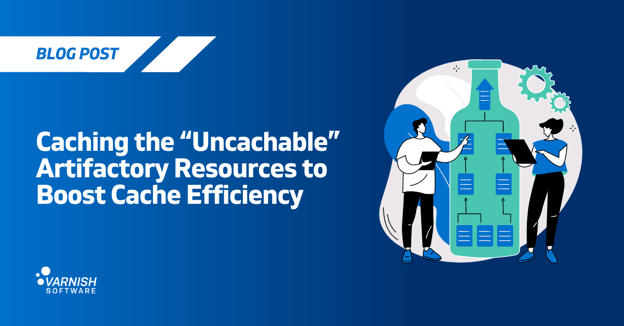DevOps bottlenecks are frustrating. Long artifact retrieval times slow down CI/CD pipelines, increase cloud costs and impact developer productivity. But what if you could cache and store large artifacts instantly and eliminate redundant downloads? That’s exactly what Varnish Enterprise’s Massive Storage Engine (MSE) does.
This blog post is about the remarkable ways in which Varnish Enterprise’s Massive Storage Engine (MSE) solves this challenge, specifically within DevOps contexts where efficient delivery of large developer artifacts like repositories and images is business critical.
Balancing Cost & Performance in DevOps Infrastructure
Organizations managing artifact repositories at scale frequently face long wait times due to slow artifact retrieval and high infrastructure or cloud costs as demand scales. These inefficiencies directly impact developer productivity, build times and business performance. Scaling infrastructure to address these issues is expensive, but without optimization, delays in CI/CD pipelines slow down software delivery and innovation.
Common Challenges in Artifact Management
- Latency & Bottlenecks – Artifacts must travel long distances, slowing down global teams.
- Server Overload – High-frequency requests to Artifactory create network congestion.
- Inefficient Caching – Traditional storage solutions fail to persist large DevOps artifacts efficiently.
Massive Storage Engine is Powerful Cache Storage
Traditional storage solutions weren’t designed for fast artifact retrieval. Every CI/CD pipeline run downloads the same files repeatedly, leading to slow builds and high costs. Caching fixes this problem, but not all caching is equal. That’s where Varnish Enterprise’s MSE stands out.
How does MSE help enterprises experiencing these bottlenecks and cost pressures? Let’s quickly review Varnish and see where MSE fits in. Varnish's core strength lies in its advanced caching engine. This engine stores responses from the origin application, efficiently serving them to clients upon subsequent requests. This process significantly offloads the burden from Artifactory and other HTTP-based applications. Varnish's design enables it to handle numerous requests without requiring extensive server resources.
While in-memory caching is effective, artifact caching scenarios demand disk storage solutions for managing large data volumes. MSE extends Varnish Enterprise beyond in-memory caching to intelligent, disk-based artifact caching. While the open-source Varnish Cache stores objects in RAM, MSE enables high-speed, high-capacity caching for massive artifacts.
MSE includes:
- Efficient Object Storage – Pre-allocates large files to reduce disk fragmentation & IOPS.
- Optimized Cache Eviction – Automatically removes the least-accessed artifacts.
- Cross-Cloud & On-Prem Compatibility – Works seamlessly in AWS, Azure, Kubernetes, and hybrid environments.
The result? Faster builds, lower infrastructure costs, and a seamless developer experience.
Want to see MSE in action? Schedule a demo today.
Why Persistent Caching Matters for DevOps
Unlike traditional caching that resets on restart, MSE provides cache persistence, ensuring:
- Faster cold-start times when rebooting infrastructure.
- Reduced load on primary artifact storage (Artifactory, S3, on-prem repositories).
- Reliability & Failover Protection – Hot storage is always available, minimizing disruptions.
MSE also supports distributed caching, enabling global DevOps teams to access cached artifacts without repeatedly pulling from the origin repository. This improves collaboration, CI/CD speeds, and multi-region deployments. It also allows operators to precisely configure storage in Varnish Enterprise, facilitating the creation of a persistent data caching cluster, capable of managing petabytes of data.
As a fully integrated component of Varnish Enterprise, MSE incorporates integrity checks and error handling to prevent and mitigate downtime. It is ideally suited for caching large data sets such as videos, metadata, and DevOps artifacts.
A Massive Storage Engine Success Story
A leading enterprise software company managing 1,000 TB of artifact traffic per month faced:
- High cloud bandwidth costs due to frequent artifact fetches.
- Slow CI/CD performance impacting distributed developer teams.
- Scaling limitations with existing Artifactory instances.
By integrating Varnish Enterprise as a caching layer with MSE built in, the company accelerated software delivery while cutting infrastructure costs.
- Reduced Artifactory API calls by 70% → Fewer redundant requests, lower compute costs.
- Increased build speed by 80% → Cached artifacts were instantly available.
- 20% reduction in monthly bandwidth expenses → Lower cloud egress fees.
Varnish Enterprise’s Massive Storage Engine (MSE) is designed for high-scale, high-performance DevOps workflows. Want to see how MSE can improve your build pipelines? Watch our webinar on demand
You can also schedule a demo today with a technical expert.
/VS-logo-2020-197x60.png?width=136&height=60&name=VS-logo-2020-197x60.png)




